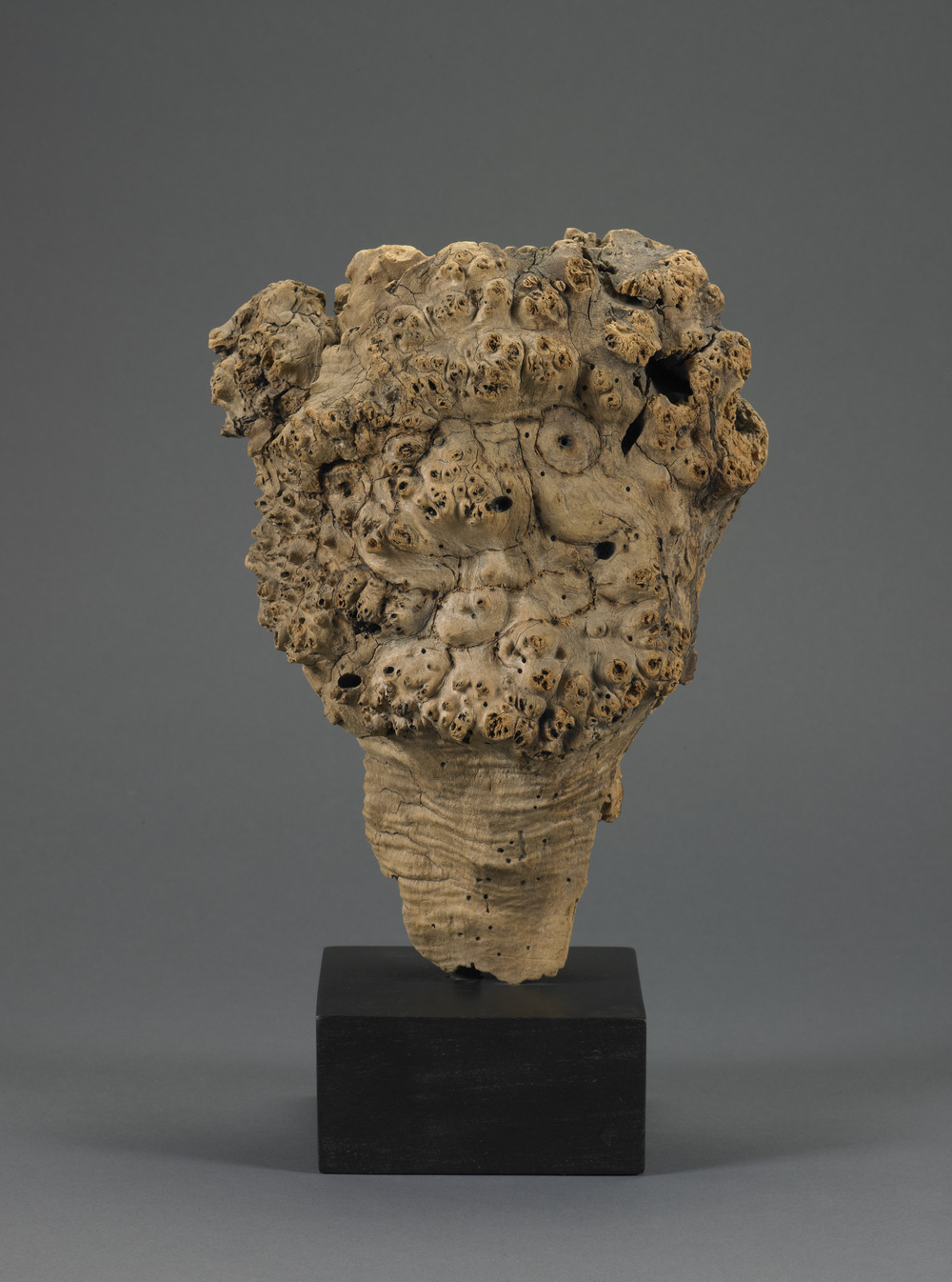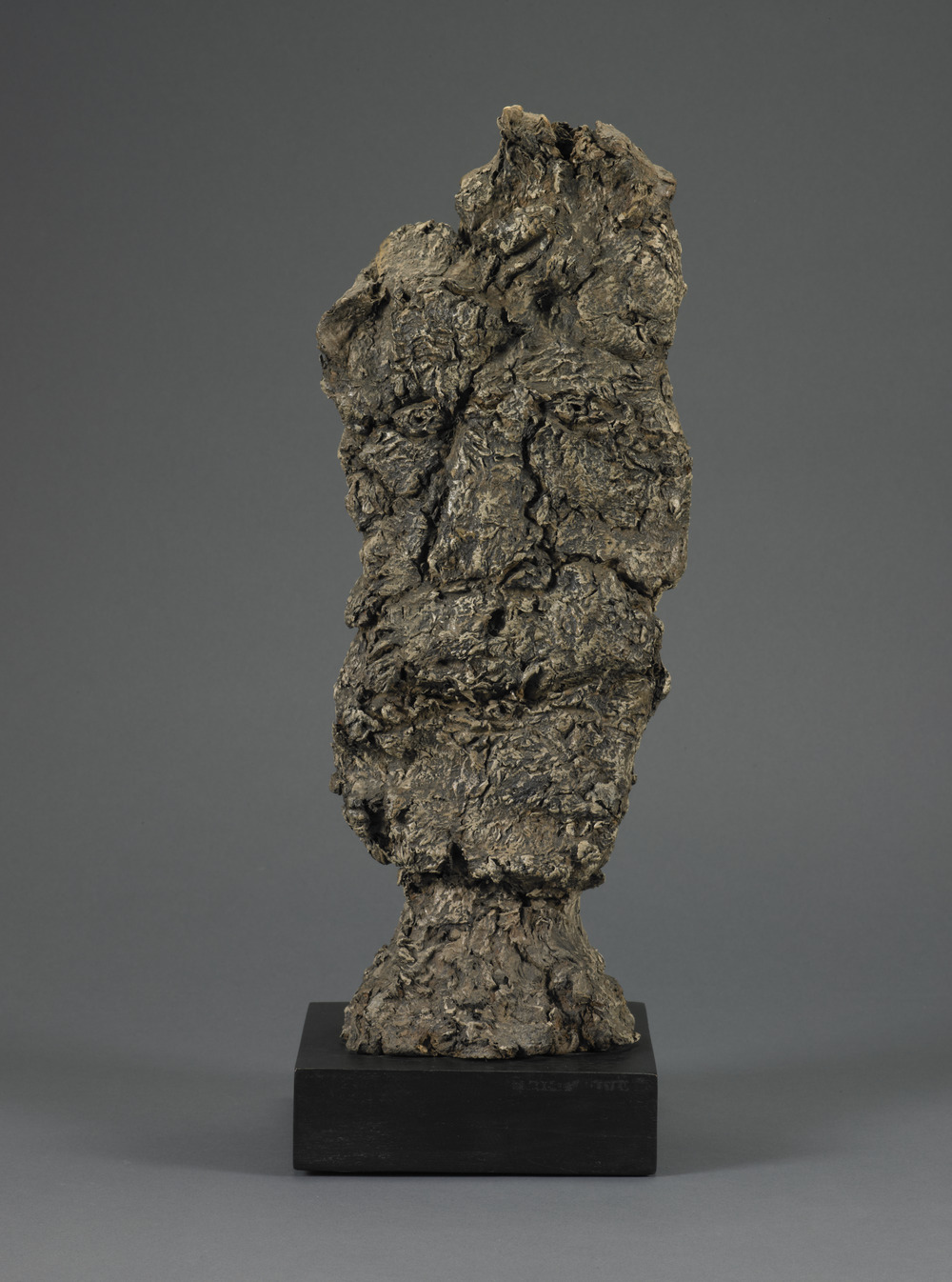Jean Dubuffet, Tête barbue, 1959, and Poches aux yeux, 1959


Karen K. Butler
Independent art historian
Formerly associate curator, Mildred Lane Kemper Art Museum
Jean Dubuffet’s sculptures Tête barbue (Bearded Head) and Poches aux yeux (Bags under the Eyes) follow his practice of making intentionally childlike, humorous, and even scatological art. Tête barbue is made from a piece of driftwood that the artist found on the beach in the Côte d’Azur. Attracted by the object’s natural resemblance to a human head, and in particular the barnacle-like protrusions that suggest hair and a beard, the artist burned holes for eyes and a nose and then placed it upright on a pedestal, elevating the lowly object to the level of fine art. Not much bigger than an actual head, the little wooden sculpture seems to equivocate between the banality of a child’s plaything and a more bothersome sensation caused by the unsightly knobs and bumps that spread across the face and head. Poches aux yeux also vacillates between prosaic charm and visceral ugliness. Here, using the craft technique of papier-mâché instead of a found object, the artist shaped and formed an elongated and flattened head. With judicious incisions, he accentuated the ridges and folds of the crumpled newspaper, making long cracks around the eyes, nose, and mouth and forming bags under the eyes. He then rubbed the sculpture with black shoe polish, giving its surface a scuffed and worn-out appearance. Made of ephemeral materials, both sculptures are fragile, unstable little objects that speak to Dubuffet’s desire to undermine traditional notions of the accepted monumentality of sculpture while also commenting on the disposable, commodity-driven nature of life in 1950s France.
These sculptures are part of a larger series that Dubuffet began in 1954 titled Petites statues de la vie précaire (Little statues of precarious life), made from diverse and nontraditional materials such as newspaper, cinders, steel wool, sponges, and found objects, which he scavenged for in places as varied as neighborhood waste bins, steam locomotive depots, and even the garage where he parked his car. Between October 1959 and November 1960 Dubuffet made a second group of sculptures in which he used not only found debris but also papier-mâché and common household materials such as crumpled and torn aluminum foil, floor wax, and shoe polish.1 In a letter written to his friend the Surrealist writer André Pieyre de Mandiargues in 1960, the artist explained how he made the works:
The little statues are merely papier-mâché (newspapers crudely torn, soaked, and molded with glue, forming a paste that I then dye en masse with colored inks). In certain cases the statues remained as they were (and it is these that I prefer); this forms a barbarous material, nonhomogeneous, endowed with expression; in other cases, once they have dried and hardened, they have been more or less rubbed with oil paint . . . and sometimes after that waxed with pure wax or with shoe polish (two of these which are at Berggruen’s have been treated like old combat boots, these are “Le Cigare” and “Poches aux yeux”). Two or three have been covered with sheets of aluminum paper that has been crumpled and polished with oil paint.2
Here Dubuffet responds to his friend’s curiosity with an air of matter-of-factness, emphasizing both the simplicity and rawness of his means of production and the lack of refinement with which he has treated his materials. He also hints at his more conceptual objectives—to create a barbarous, nonhomogeneous sculpture that, because of its unrefined nature, is endowed with a more “authentic” form of expression.
From the time he began actively making art around 1942, Dubuffet had set out to bring art down from its pedestal, so to speak, rejecting the established notions of taste, skill, and beauty that he felt were at the core of Western culture. Some of the alternative models for his approach to art were the work of the mentally ill as well as tribal, naive, and folk art, which he compiled under the rubric art brut.3 Dubuffet coined the term to describe a type of crude or raw art made by individuals “unscathed by artistic culture.” For the first exhibition of art brut in 1949, much of which came from the artist’s personal collection, he wrote his best-known text on the subject, defining the “brut” artist as one who was by nature free from all convention: “These artists derive everything—subjects, choice of materials, means of transposition, rhythms, styles of writing, etc.—from their own depths, and not from the conceptions of classical or fashionable art. We are witness here to a completely pure artistic operation, raw, brute, and entirely reinvented in all of its phases solely by means of the artist’s own impulses.”4 Although Dubuffet, by his own definition, was not a maker of art brut, he embraced its outsider position and transgressive procedures—caricature, humor, and untutored crudeness, to name a few—as an alternative to what he saw as the stultifying, deadening effects of an outdated fine arts tradition.
Indeed, the Petites statues de la vie précaire utilize not only the naive materials of art brut but also, and perhaps more importantly, the distortions of the body common to the genre, including grossly enlarged facial features and crudely rendered, flattened bodies. With these statues the artist’s attack on culture coalesces around the figure, more particularly the face and head, the traditional sources of psychological expression. The titles of some of the works in the series do, in fact, point to inner emotion: for example, Le fanfaron (The Boaster), Le boudeur (The Sulker), L’étonné (The Surprised One), Le funébreux (The Gloomy One), or even more obliquely Poches aux yeux (Bags under the Eyes). But rather than being the outcome of careful mimetic rendering and traditional descriptive artistic practices, or even a more modern form of gestural expressionism, these emotions are suggested by the disfiguring outcomes of the haphazard application of papier-mâché or crumpled tinfoil or simply by the chance operations of nature on a piece of wood. In short, they are “found” emotions, having nothing to do with the traditional values of authenticity and genuineness associated with the marks left by the artist’s hand on the raw sculptural material.5 Dubuffet’s emphasis on facial expression also recalls the tradition of the tête d’expression or tête de caractère, a form of figure painting that emerged in the eighteenth century but was prevalent in academic practice throughout the nineteenth and even into the early twentieth century, appearing frequently in the Salons. These were almost always depictions of life-size heads, representing simple passions such as fear, anger, or joy and titled as such. Dubuffet’s sculptures, however, call this academic practice into question by replacing it with caricature and exaggeration as well as banal and untutored artistic techniques that are more common in the art of children or the insane than they are in the fine arts tradition of portraiture.
In 1960, on the occasion of a small retrospective of his work at the World House Galleries in New York, Dubuffet published one of his best-known explanations of his own work, titled “Anticultural Positions.” He argued that a revolution was occurring in art that promised the complete liquidation of humanism and the dead language that was culture of the West.6 For the artist, this transformation was to come from everyday life: “For myself, I aim for an art which would be in immediate connection with daily life, an art which would start from this daily life, and which would be a very direct and very sincere expression of our real life and our real moods.”7 Seen in this light, Dubuffet’s emphasis on disposable materials and his practice of de-skilling might be seen as the flip side of the heroicism and existential angst associated with postwar gestural abstraction. In its place, he offers a new “humanism,” one conditioned by nothing more serious than bearded heads and bags under the eyes. Indeed Dubuffet’s provocative celebration of a precarious art that emphasized values such as extreme contingency, antimonumentality, ugliness, lack of skill, and a preoccupation with base gestures such as smearing and smudging was a successful deflation of much of the seriousness of artistic politicking in postwar Paris.
- 1 The first series of statues created in 1954 consisted of forty-four sculptures. The second related group of thirty-two sculptures, also referred to as Petites statues de la vie précaire, was made between October 1959 and November 1960. Tête barbue and Poches aux yeux, both made in December 1959, are part of this second group of statues. For a discussion of these works, see Max Loreau, Catalogue des travaux de Jean Dubuffet: Fasc. XVII, Matériologies (Lausanne, Switzerland: Weber, 1969), and Andreas Franzke, Jean Dubuffet: Petites statues de la vie précaire (Bern, Switzerland: Gachnang & Springer, 1988).
- 2 Jean Dubuffet to André Pieyre de Mandiargues, May 13, 1960, in Prospectus et tous écrits suivants, vol. 2 (Paris: Gallimard, 1967), 449 (translation mine). Dubuffet’s letter is written in response to a letter from Pieyre de Mandiargues in which he asks how the artist made the Petites statues. See letter dated May 8, 1960, cited in Dubuffet (Paris: Editions du Centre Pompidou, 2001), 385. A selection of these little statues, including Poches aux yeux, was exhibited with Dubuffet’s lithograph series Phénomènes at the Galerie Berggruen in Paris, although the sculptures are not listed in the catalog. See Jean Dubuffet: Lithographies, Série des Phénomènes (Paris: Berggruen & Cie, 1960).
- 3 In 1948—along with André Breton, Jean Paulhan, Charles Ratton, Henri-Pierre Roché, and Michel Tapié, among others—he formed the Compagnie de l’Art Brut, a group of individuals devoted to collecting and exhibiting this kind of art. The first exhibition of art brut (approximately two hundred works by sixty-three artists) was held in October 1949 at the contrastingly elegant Galerie René Drouin on the Place Vendôme in Paris.
- 4 Jean Dubuffet, “Art Brut in Preference to the Cultural Arts” (1949), trans. Paul Foss and Allen S. Weiss, Art and Text 27 (December–February 1988): 31–33.
- 5 In comparison one might think of Rodin’s more refined and traditional sculptures, in which expression comes from the artist’s touch on a clay model and from the brilliant patina of the centuries-old tradition of bronze casting.
- 6 See Jean Dubuffet, “Anticultural Positions,” in J. Dubuffet (New York: World House Galleries, 1960), n.p. This is the text of a lecture given by Dubuffet at the Arts Club of Chicago in December 1951. The exhibition included Tête barbue, which is number 40 on the checklist.
- 7 Ibid., n.p.